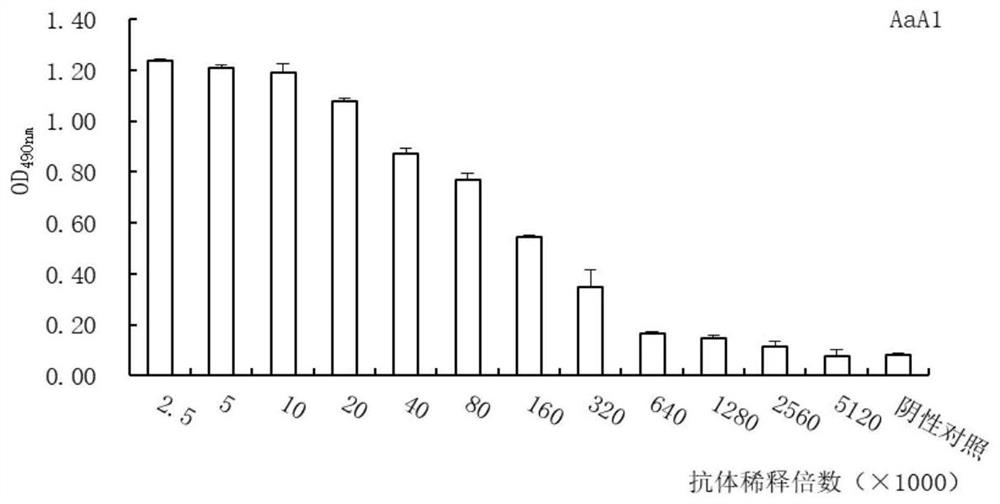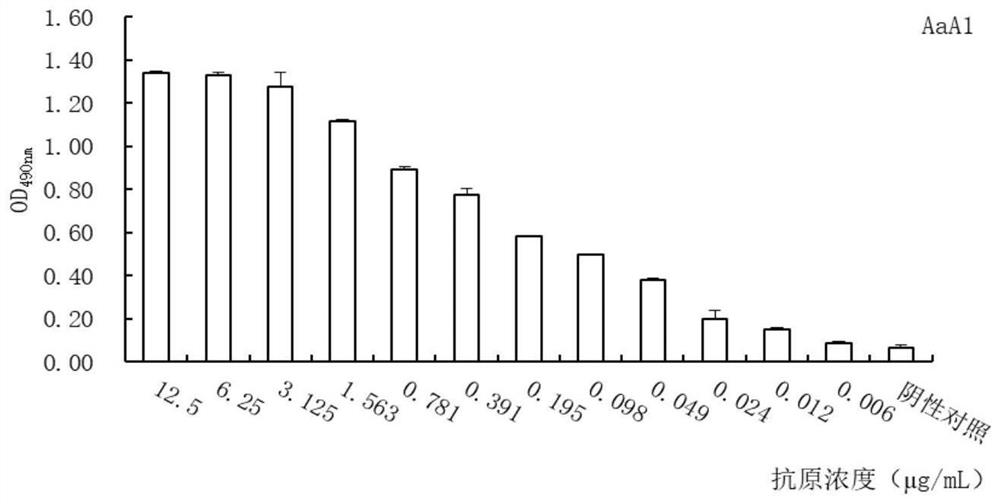Monoclonal Antibody Recognizing Alternaria and Its Hybridoma Cell Line aaa1
A hybridoma cell line and monoclonal antibody technology, applied in the animal field, can solve problems such as agricultural production losses and achieve strong specific effects
- Summary
- Abstract
- Description
- Claims
- Application Information
AI Technical Summary
Problems solved by technology
Method used
Image
Examples
Embodiment 1
[0018] Embodiment 1: Preparation of hybridoma cell lines
[0019] (1) Antigen preparation: Pick single colonies of Alternaria and inoculate them in potato dextrose liquid medium, shake and culture at 25°C for 4-5 days, collect spores and hyphae in a 50mL centrifuge tube, 6000r / min Centrifuge for 20 min, wash twice with PBS, ultrasonically crush (power 200W, crush for 2 s, intermittently for 2 s), centrifuge the crushed solution at 6000 r / min for 20 min, collect the supernatant, measure the supernatant protein content with the Coomassie brilliant blue method, adjust The protein concentration is 1000 μg / mL, and it is used as the initial antigen for immunization antigen and later detection. The antigen solution is aliquoted in a small amount and then stored in a freezer at -80°C. Take a small amount and store at -20°C before use.
[0020] (2) Three healthy BaL b / c mice aged 10-12 weeks were selected and injected intraperitoneally with 200 μL of antigen emulsified with an equal a...
Embodiment 2
[0023] Embodiment 2: the production of monoclonal antibody
[0024] Take BaL b / c mice about 8 weeks old, inject 0.3mL pristane intraperitoneally, and inject 5-10×10 5 7-10 days after injection, the peritoneal cavity of the mouse was obviously swollen. The ascites was collected, centrifuged at 2000r / min for 3min, and the supernatant was collected, which was the ascitic monoclonal antibody. Monoclonal antibodies were purified by Protein A column chromatography and stored at -80°C. The monoclonal antibody prepared from the AaA1 cell line is a monoclonal antibody that can specifically recognize Alternaria.
Embodiment 3
[0025] Example 3: Titer detection experiment of monoclonal antibody
[0026] Antibody titer was determined by indirect ELISA method. Dilute 1000μg / mL Alternaria antigen 1000 times with the coating solution and coat the whole plate (1μg / mL), overnight at 4°C, make it adsorb to the wells of the polystyrene plate, wash with PBST three times Block with skimmed milk for 60 min. Add monoclonal antibody AaA1-fold dilution to coated wells, add 100 μL to each well, wash at 37°C for 1 h, wash three times with PBST, then add 100 μL of horseradish peroxidase-labeled rabbit anti-mouse (Sigma Company) diluted 5000 times according to the instruction manual, 37 ℃1h, after washing with PBST, add OPD substrate chromogenic solution to develop color, use 50μL 2M H 2 SO 4 After terminating the reaction, read the OD with a microplate reader 490nm , To determine the titer of monoclonal antibody ascites with the ratio of negative to positive greater than 2.
[0027] After testing, it was determi...
PUM
| Property | Measurement | Unit |
|---|---|---|
| Sensitivity | aaaaa | aaaaa |
Abstract
Description
Claims
Application Information
 Login to View More
Login to View More - R&D
- Intellectual Property
- Life Sciences
- Materials
- Tech Scout
- Unparalleled Data Quality
- Higher Quality Content
- 60% Fewer Hallucinations
Browse by: Latest US Patents, China's latest patents, Technical Efficacy Thesaurus, Application Domain, Technology Topic, Popular Technical Reports.
© 2025 PatSnap. All rights reserved.Legal|Privacy policy|Modern Slavery Act Transparency Statement|Sitemap|About US| Contact US: help@patsnap.com



